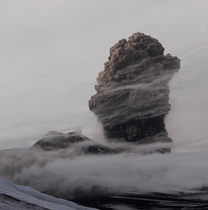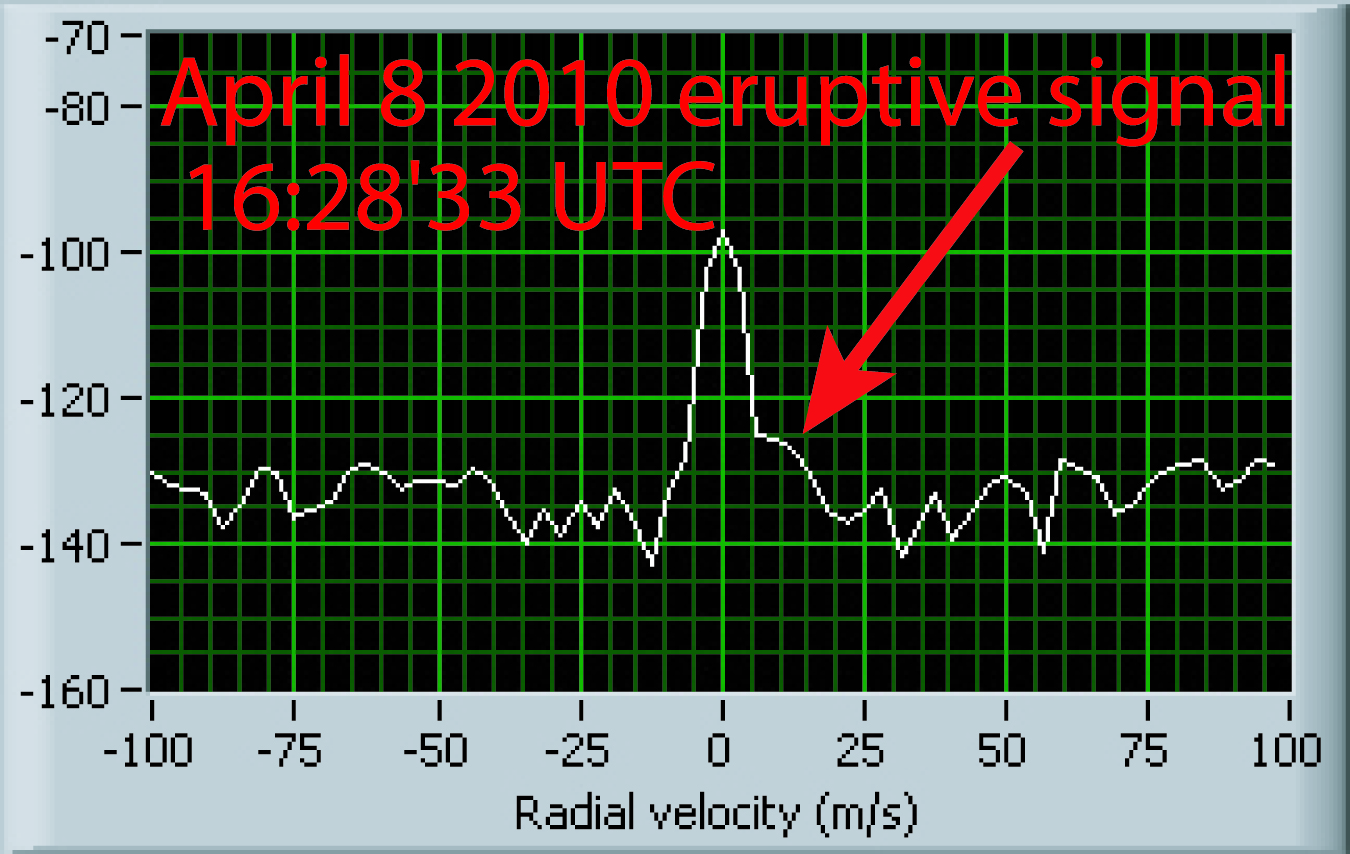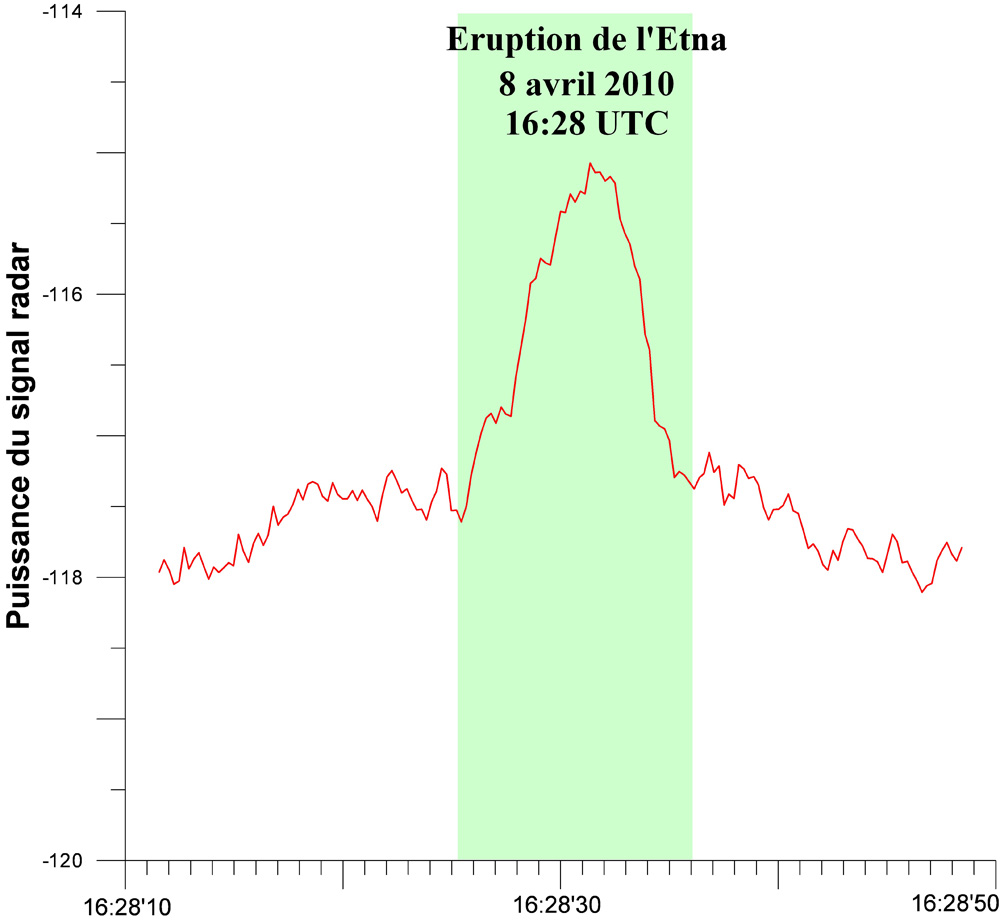|
Past eruptions of Etna recorded by VOLDORAD 2B (Before June 2013)
For information on the data set or access to source data, please contact
27 Avril 2013
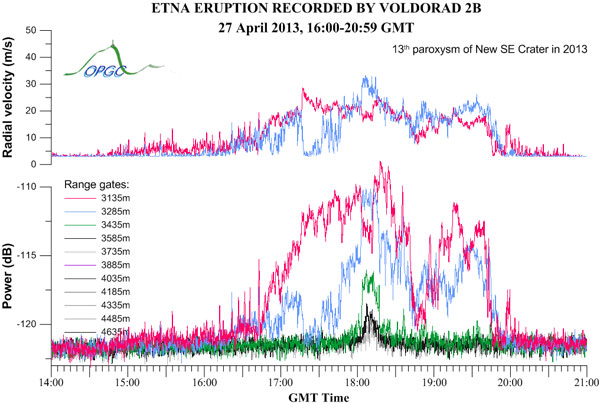
On April 27 2013, signals were again recorded by VOLDORAD 2B in mainly 5 range gates for nearly 6h, with the paroxysm spanning 16:30 to 20:00. Signals were likely associated with a new eruptive episode from the new SE Crater of Etna (the 13th in 2013). From the radar signals, this episode was less violent than the previous one on April 20.
20 Avril 2013
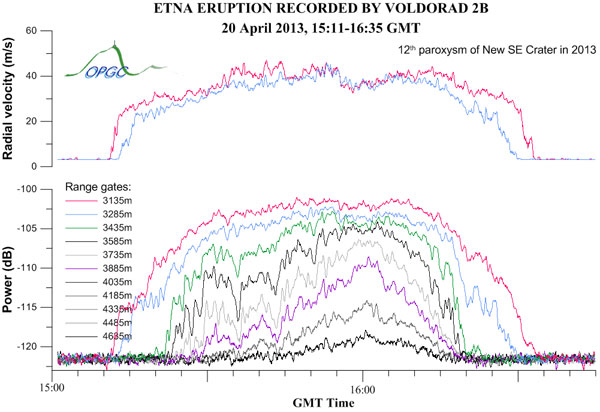
On April 20 2013, the new SE Crater of Etna produced the 12th eruptive episode with lava fountains (800-1000m high !) in 2013. The fountain-fed ash and lapilli plume drifting toward ESE produced powerful echoes during nearly 1.5 h in the 11 range gates sampled by the OPGC radar (VOLDORAD 2B) at La Montagnola, operated jointly with INGV Catania. Radial velocities sometimes exceeded 50 m/s.
18 Avril 2013
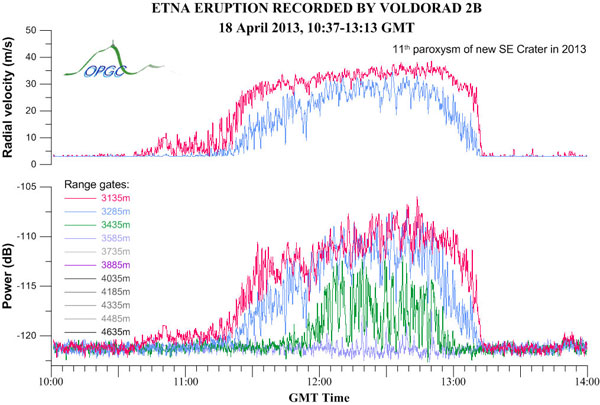
On the 18 of April 2013, the new SE Crater of Etna produced the eleventh eruptive episode with lava fountains in 2013, 1 week after the previous eruptive episode from the same crater. The OPGC radar VOLDORAD 2B, located at La Montagnola and operated jointly with the INGV Catania, was able to detect echoes in up to 4 range gates (3135m - 3585m) due to the fountain-fed ash and lapilli plume.
12 Avril 2013
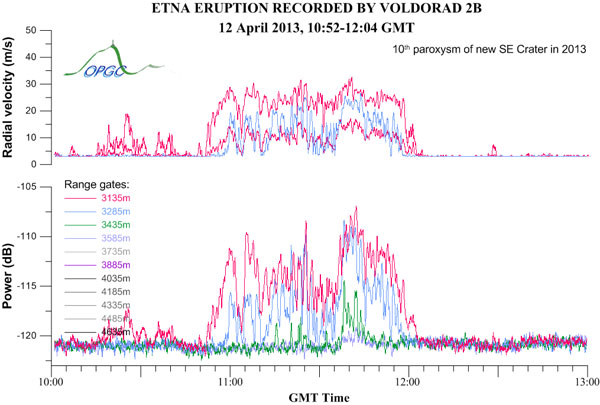
On the 12 of April 2013, the new SE Crater of Etna produced the tenth eruptive episode with lava fountains and lava flows in 2013, 9 days after the previous eruptive episode from the same crater. The OPGC radar VOLDORAD 2B, located at La Montagnola and operated jointly with the INGV Catania, was able to detect echoes in up to 4 range gates (3135m - 3585m) due to the fountain-fed ash and lapilli plume.
3 Avril 2013
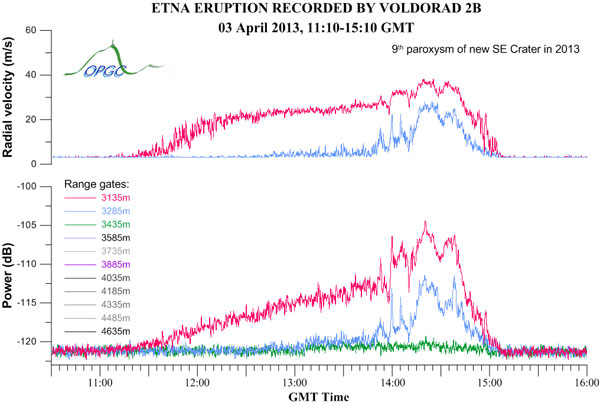
On the 3d of April 2013, the new SE Crater of Etna produced the ninth eruptive episode with lava fountains in 2013, 2.5 weeks after the previous eruptive episode from the same crater The OPGC radar VOLDORAD 2B, located at La Montagnola and operated jointly with the INGV Catania, was able to detect echoes in the first 2 range gates (3135m - 3285m) due to the fountain-fed ash and lapilli plume blown to the South East by the wind.
16 Mars 2013
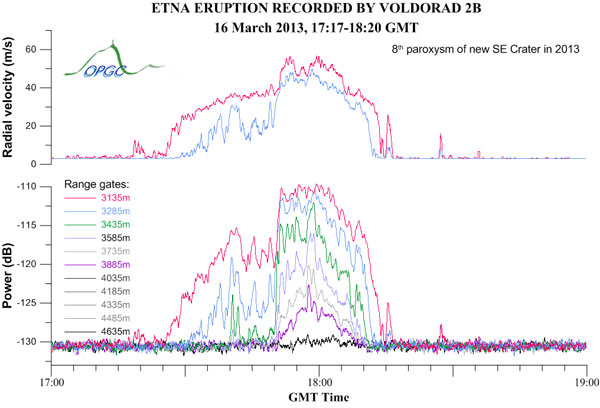
During the evening of March 16 2013, Etna's New SouthEast Crater produced its 8th paroxysmal eruptive episode in one month, with lava fountains, lava flow emission, and generation of an eruption column blown to the South East, leading to fallout of ash and scoriae in Zafferana Etnea, Santa Venerina, and north of Acireale. See the website of INGV Catania (http://www.ct.ingv.it/) for more details.
The OPGC radar VOLDORAD 2B, located at La Montagnola about 3 km south of the summit craters, and exploited jointly with INGV Catania, was able to detect the fountain-fed ash-and-scoria plume in 11 range gates. Measured echo power and radial velocities are shown for different range gates in the graph.
5-6 Mars 2013
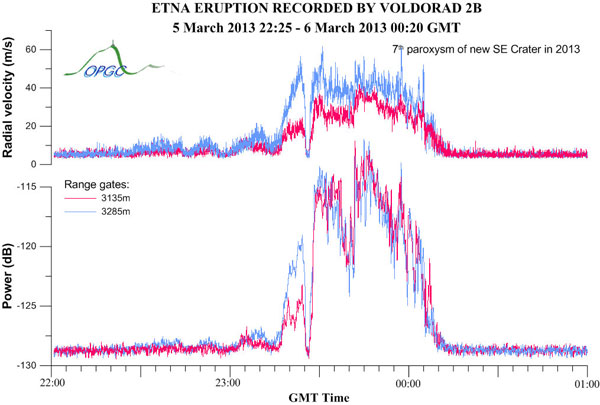
During the night of 5-6 March 2013, Etna's New Southeast Crater has produced yet another paroxysmal eruptive episode, the seventh in 2013, with high lava fountains, lava flow emission, and generation of an eruption column blown to the North East, leading to heavy fallout of ash and scoriae in the northeastern sector of the volcano. Strombolian activity also occurred at the Voragine. See the website of INGV Catania (http://www.ct.ingv.it/) for more details.
The OPGC radar VOLDORAD 2B, located at La Montagnola, about 3 km south of the summit craters, was able to detect the fountain-fed ash-and-scoria plume in 11 range gates. Measured echo power and radial velocities are shown for two range gates in the graph.
28 Février 2013
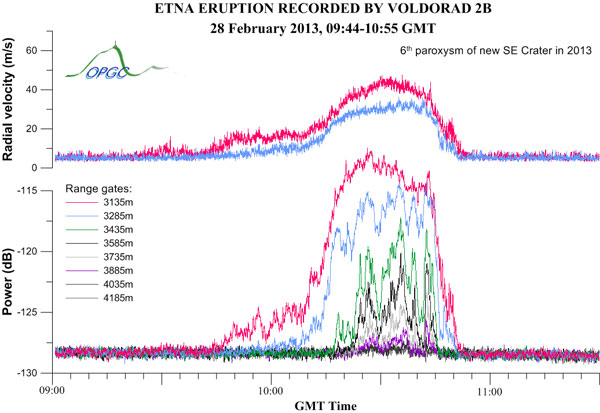
On the late forenoon of 28 February 2013, Etna's New Southeast Crater has produced yet another paroxysmal eruptive episode, the sixth in 2013. A large plume was blown Eastward, leading to heavy fallout of ash and scoriae ash and scoriae on Etna's eastern flank and on the Ionian coast. An eruptive fissure opened in the saddle between the old and new cones of the Southeast Crater, emitting a lava flow toward Valle del Bove. Activity also occurred at the Voragine and at the Bocca Nuova. See the website of INGV Catania (http://www.ct.ingv.it/) for more details.
23 Février 2013
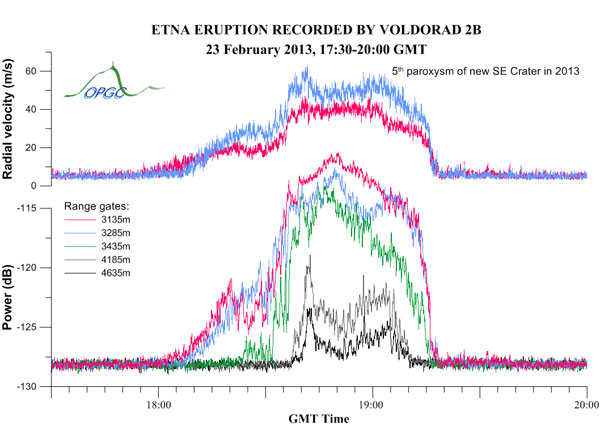
In the evening of 23 February, about two-and-a-half days after the previous lava fountaining episode, the New Southeast Crater (NSEC) of Etna was the site of a new spectacular paroxysm, the fifth in 2013, and also the most violent.
21 Février 2013
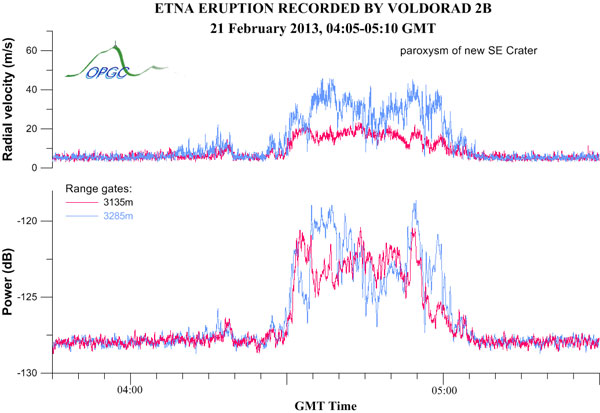
In the morning of February 21 2013, a new episode of lava fountaining (the fourth in the last 50 hours) took place at Etna's New Southeast Crater. The paroxysm lasted about half an hour, generating an ash cloud that was blown to the north by the wind. Like in the preceding episodes, lava flows were also produced (cf. INGV website http://www.ct.ingv.it/).
19 Février 2013
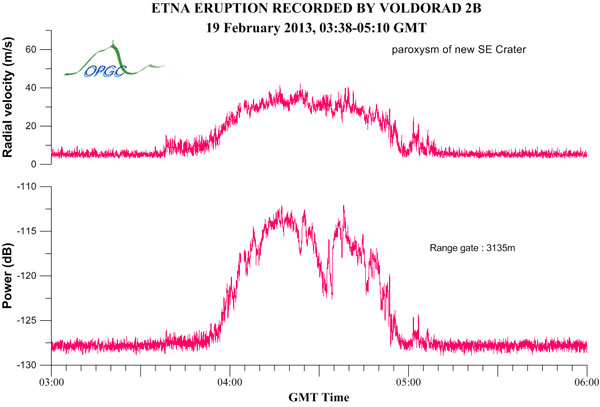
On February 19 2013, the new SE Crater of Etna produced its first paroxysmal eruptive episode in 2013 (26th since January 12 2011), the first since the last lava fountain on April 24 2012.
The OPGC radar VOLDORAD 2B, located at La Montagnola and operated jointly with the INGV Catania, was able to detect echoes from the volcanic plume in 9 range gates (3135m - 4335m).
Années précedentes
2012
24 Avril 2012
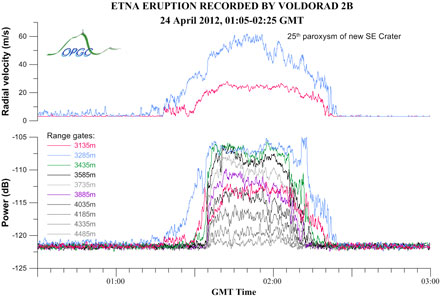
On April 24 2012, the new SE Crater of Etna produced its 25th paroxysmal eruptive episode of the series initiated on January 12 2011 (7th in 2012), after a 11.5 days quiet period, similar to the previous inter-eruption interval. Lava fountains were again produced in the night, feeding an ash and lapilli plume. See the INGV Catania website for more details on the activity.
The OPGC radar VOLDORAD 2B, located at La Montagnola and operated jointly with the INGV Catania, was able to detect echoes from the fountain-fed ash and lapilli plume in up to all (11) range gates (3135m - 4635m). A very weak echo, likely caused by emission of dilute ash, was first recorded from about 23:40 GMT on April 23 in the 3285 m range gate, maintaining at very low level until 01:05 GMT on April 24. At this time, velocities and backscattered power measured in the 3135 and 3285 m bins progressively increased. Sligthly before 01:30 the increase in signals amplitude, and thus of the activity, became more pronounced and at 01:35 the plume was detected all range gates (11) indicating the beginning of the lava fountain paroxysm. This also suggests a strong wind component to the North stretching the plume over at least 1650m at the beam elevation (3-4 km a.s.l.). The echo power maintained at a high level in all sounded volumes for 20 minutes (until 01:55), when particle radial velocities peaked at nearly 60 m/s (certainly helped by strong winds). Then, the echo power started to decrease progressively in all gates until about 02:15 when signals disappeared from the gates beyond 3585 m. This certainly marked the end of the lava fountains feeding the plume. Signals in closer range gates were back to background level at 02:25.
12 Avril 2012
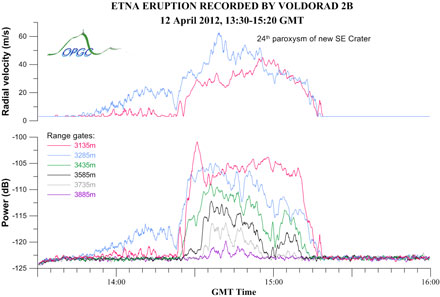
On April 12 2012, the new SE Crater of Etna produced its 24th paroxysmal eruptive episode of the series initiated on January 12 2011 (6th in 2012), after a 10.5 days quiet period. Lava fountains were again produced in the afternoon, feeding a dense ash and lapilli plume. Lava flows went down the Valle del Bove. See the INGV Catania website for more details on the activity.
The VOLDORAD 2B radar at La Montagnola was able to detect echoes from the fountain-fed ash plume in up to 6 range gates (3135m - 3885m) from 13:30 to 15:20 GMT. This episode was of similar duration (about 1h50) and intensity to its predecessor on April 1st. Radar echoes were detected from 13:30 GMT in the 3135 and 3285 m range gates, showing a very progressive augmentation in echo power and radial velocities until the paroxysm between 14:23 and about 15:10. Maximum radar velocities were mainly in the range 30-45 m/s but shortly reached over 60 m/s before 14:40. Echoes were detected in 6 range gates between 14:30 and 15:15. The echo power and recorded velocities dropped after 15:10 GMT, certainly marking the end of the lava fountain. Signals were back to background noise less than 10 minutes later.
1er Avril 2012
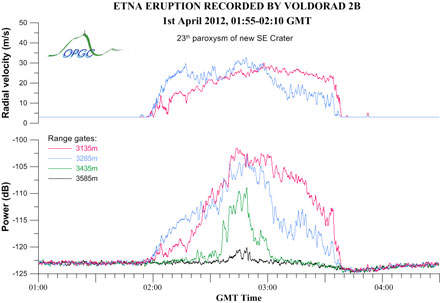
On April 1st 2012, the new SE Crater of Etna produced its 23d paroxysmal eruptive episode of the series initiated on January 12 2011 (5th in 2012), after two weeks of relative calm. Tall lava fountains were again produced in the early morning hours, feeding an ash and lapilli plume that rose several kilometers in height above the crater and drifted to the South East. Lava flows went down the Valle del Bove. See the INGV Catania website for more details on the activity.
The VOLDORAD 2B radar at La Montagnola was able to detect echoes from the fountain-fed ash plume in up to 4 range gates (3135m and 3585m) from 01:55 to 03:40 GMT. This episode was of slightly lower duration (about 1h45) and stronger intensity than its predecessor on March 18. Radar echoes were detected from 01:55 in the 3135 and 3285 m range gates, showing a progressive augmentation in echo power and radial velocities until the paroxysm between 02:40 and about 03:00. At this stage, radar velocities reached over 30 m/s and echoes were detected in 4 range gates. The echo power and recorded velocities dropped after 03:00 and dropped again significantly at about 03:35 GMT, certainly marking the end of the lava fountain. Signals were back to background noise 5 minutes later.
18 Mars 2012
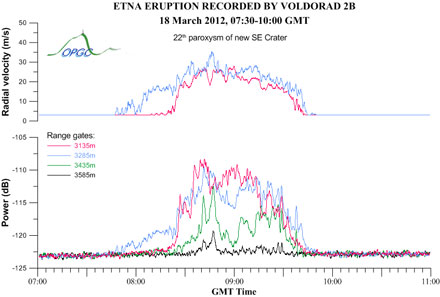
On March 18 2012, the new SE Crater of Etna produced its 22th paroxysmal eruptive episode since January 12 2011 (4th in 2012), after two weeks of relative calm. Lava fountains were produced, feeding an ash and lapilli plume that rose several kilometers in height above the crater and drifted to the East. Lava flows went down the Valle del Bove. See the INGV Catania website for more details on the activity.
The VOLDORAD 2B radar at La Montagnola was able to detect echoes from the fountain-fed ash plume in 4 range gates (3135m and 3585m) from 07:30 to 10:00. This episode was comparable in duration (about 2h) and intensity to its predecessor on March 4. Although radar echoes were detected from 07:30 (3285m), the sharp augmentation in echo power at 08:25 in the 3135 and 3285m range gates probably marked the beginning of the lava fountains at the new SE crater. The echo power increased until the paroxysm after 8:40. At this stage, radar velocities reached over 30 m/s and echoes were detected in 4 range gates. The echo power dropped at about 08:50 GMT and maintained at lower level until 09:15 when radar signals progressively decreased during half an hour, certainly marking the end of the lava fountain. At 10:00 the ash plume emission was substantially over.
04 Mars 2012
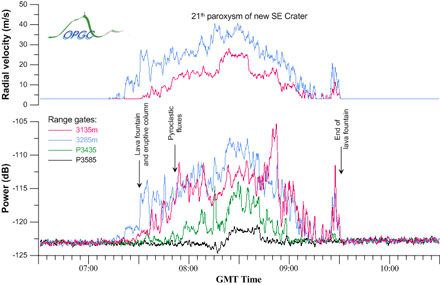
On March 4 2012, the new SE Crater of Etna produced its 21th paroxysmal eruptive episode since January 12 2011 (third in 2012), preceded by several days of gentle intra-crateric Strombolian activity. Lava fountains occurred between 07h30 and 09h30 GMT, feeding an ash plume that rose several kilometers in height above the crater and drifted to the North East. A lava flow was emitted down the Vale del Bove and small pyroclastic flows and lahars were released. See the INGV Catania website for more details on the activity.
The VOLDORAD 2B radar at La Montagnola was able to detect echoes from the fountain-fed ash plume in 4 range gates (3135m and 3585m) from 07:20 to 09:32. This episode was shorter (about 2h) and more violent than its predecessor on February 9. Although radar echoes were detected from 07:20, the sharp augmentation in echo power at 3135 and 3285m marked the beginning of the lava fountain at the new SE crater. The echo power progressively increased until the paroxysm between 08h22 and 08h42 GMT. At this stage, radar velocities reached over 40 m/s and echoes were detected in 4 range gates. The radar echo power then decreased until 09:25 when a resumption occurred until the final abrupt decrease at 09:32 marking the end of the lava fountain and of the main ash plume emission.
09 Fevrier 2012
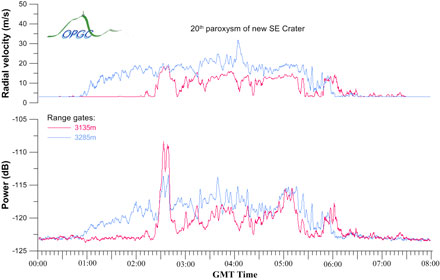
On February 9 2012, the new SE Crater of Etna produced its 20th paroxysmal eruptive episode since January 12 2011, between 23h30 on 08/02/2012 and 09:00 on 09/02/2012. An ash plume about 6 km in height was generated by the lava fountains and drifted to the West; a lava flow also went down Vale del Bove. The VOLDORAD 2B radar at La Montagnola was able to detect echoes from the fountain-fed ash plume in mainly 2 range gates (3135m and 3285m). It is one of the longest duration (>5h) recorded in this series of events at this crater. As seen from the power amplitude, this episode was much less intense than its predecessors and grew very progressively in intensity. Radial velocities remained mostly stable around 20 m/s between 02:00 and 05:00 GMT. A peak in power, not related to reported observations, occurred around 02:30 GMT.
05 Janvier 2012
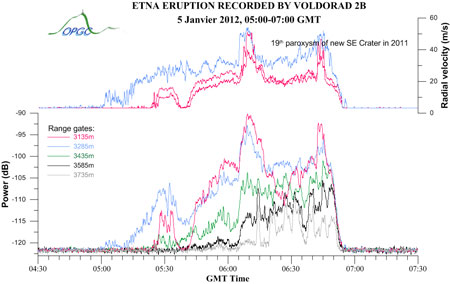
2011
15 Novembre 2011
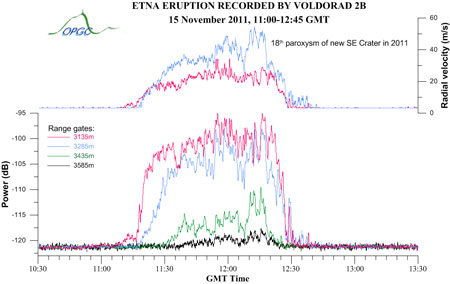
The 18th paroxysmal eruptive episode of Etna in 2011 took place on November 15. The VOLDORAD 2B Doppler radar at La Montagnola, operated jointly by INGV and OPGC, was able to detect echoes from the lava fountains and ash plume in 4 range gates (3135m, 3285m, 3435m, 3585m), the first two being characteristic of emissions at the new SE crater. Radar signals from the ash plume were recorded between 11:00 and 12:45 GMT. This new eruptive event was shorter and more violent than previous paroxysms in terms of echo power and ejecta velocities.
23 Octobre 2011
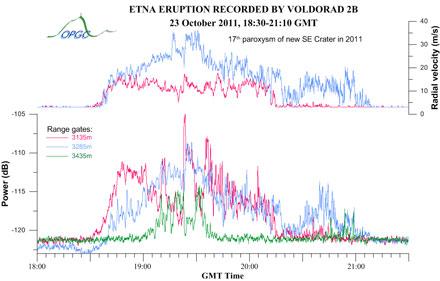
The 18th paroxysmal eruptive episode of Etna in 2011 took place on November 15. The VOLDORAD 2B Doppler radar at La Montagnola, operated jointly by INGV and OPGC, was able to detect echoes from the lava fountains and ash plume in 4 range gates (3135m, 3285m, 3435m, 3585m), the first two being characteristic of emissions at the new SE crater. Radar signals from the ash plume were recorded between 11:00 and 12:45 GMT. This new eruptive event was shorter and more violent than previous paroxysms in terms of echo power and ejecta velocities. .
8 Octobre 2011
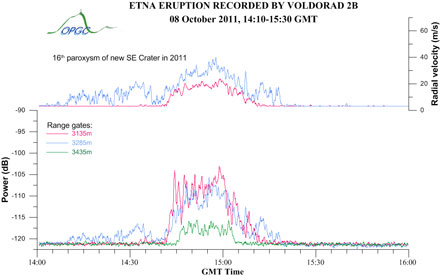
The 16th paroxysmal eruptive episode of Etna in 2011 took place on October 8. The VOLDORAD 2B Doppler radar at La Montagnola was able to detect echoes from the lava fountains and ash plume in 2 range gates (3135-3285m, characteristic of emissions at the new SE crater) between 14:10 and 15:30, and in 2 more range gates (3135m to 3585m) during the paroxysm. Like the previous one, the paroxysm of this new eruptive event was short (hasf an hour) and violent with radial velocities in the plume over 40 m/s.
28 Septembre 2011
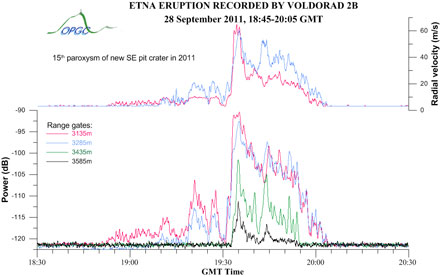
The 15th paroxysmal eruptive episode of Etna in 2011 took place in the evening of September 28. The VOLDORAD 2B Doppler radar at La Montagnola was able to detect echoes from the lava fountains and ash plume in 2 range gates (3135-3285m, characteristic of emissions at the new SE crater) between 18:45 and 20:05, and in 3 more range gates (3135m to 3735m) during the paroxysm. The paroxysm of this new eruptive event was shorter and more violent than in previous episodes.
19 Septembre 2011
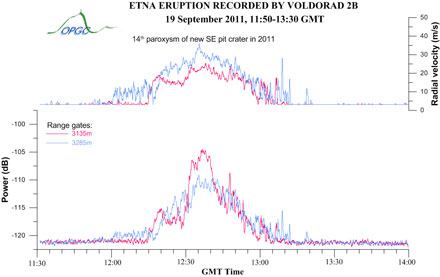
The 14th paroxysmal eruptive episode of Etna in 2011 took place on September 19. The VOLDORAD 2B radar at La Montagnola was able to detect echoes from the ash plume during the main explosive phase between 11:50 and 13:30, in mainly 3 range gates (3135-3435m) characteristic of emissions at the new SE crater.
8 Septembre 2011
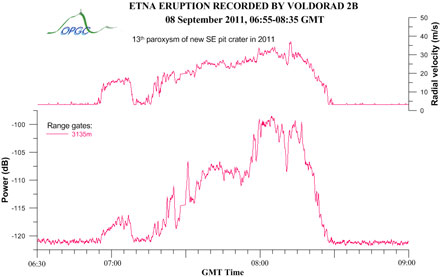
Etna's New Southeast Crater produced its 13th paroxysmal eruptive
episode in 2011, in the early morning of 8 September 2011. A tall
eruption column was entrained to the south-southeast, provoking
ash and lapilli falls on numerous towns and on the eastern part
of Catania. During this paroxysm, new vents opened on the northern
flank of the New Southeast Crater cone.
29 Aout 2011
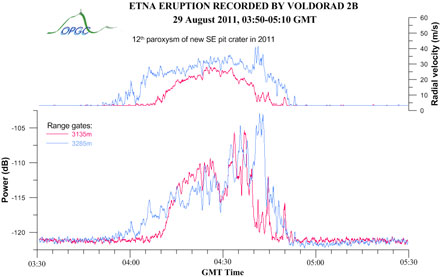
The 12th paroxysmal eruptive episode of Etna’s
new South East Crater in 2011 took place on August 29. The VOLDORAD 2B radar at La Montagnola
was able to detect echoes from the ash plume fed from lava fountains
in up to 6 range gates during the main explosive phase between 03:50 and 05:10.
Like the last eruptive episode on August 20, the August 29 event was
short (about 1 hour on radar record) and occurred after only a few hours
of weak strombolian activity. This episode was particularly spectacular
as a new eruptive fracture opened on the southeastern flank of the new cone,
feeding several lava fountains. A wide lava flow was emitted to
the East down Vale del Bove.
20 Aout 2011
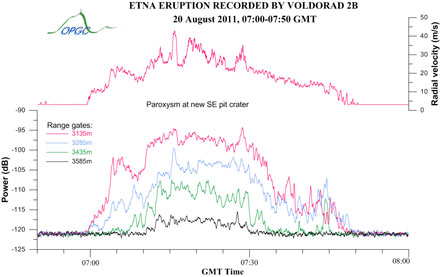
The ninth, tenth and eleventh paroxysmal eruptive episodes of Etna’s new South East Crater in 2011 took place on August 5, 12 and 20. The VOLDORAD 2B radar at La Montagnola was able to detect echoes from the ash plume in 4 range gates each time. The activity was similar to previous eruptive episodes of this crater, producing an ash plume several km high fed by lava fountains several hundred meters high at their maximum. The August 20 was the shortest (less than one hour on radar records) and the most violent.
12 Aout 2011
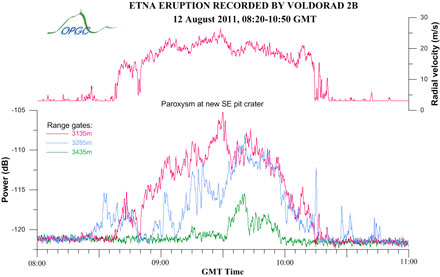
05 Aout 2011
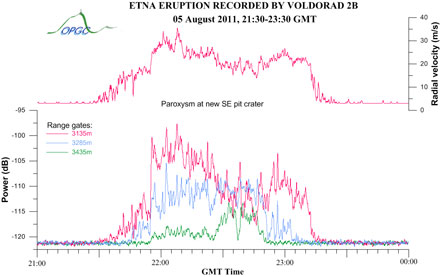
30 Juillet 2011
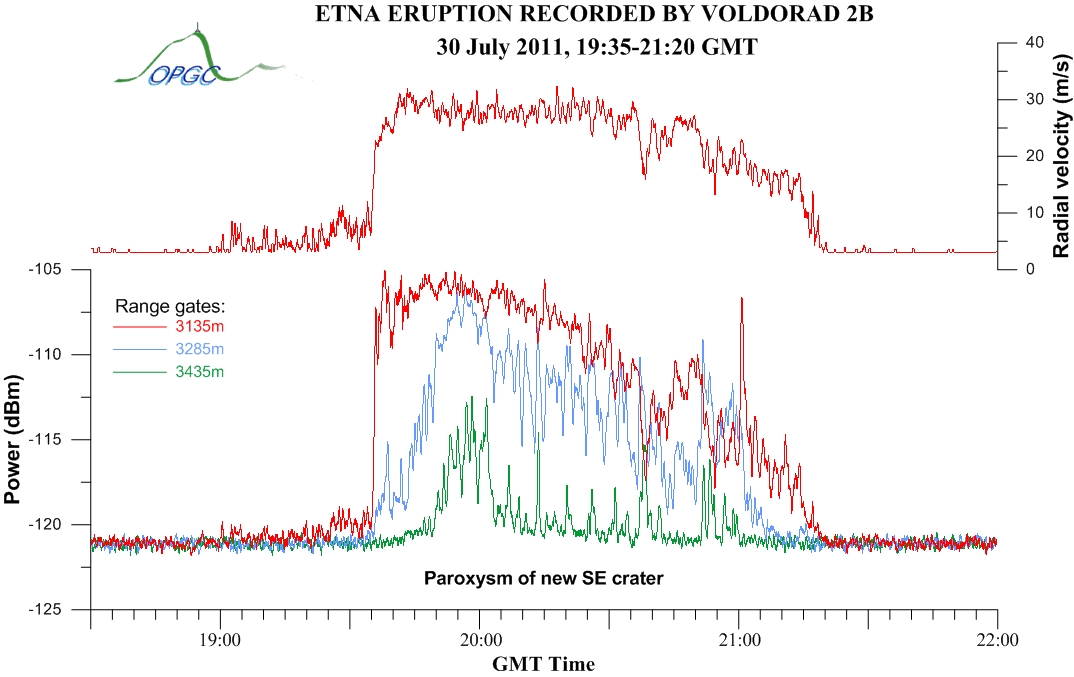
The eight paroxysmal eruptive episode of Etna in
2011 took place in the evening of July 30 2011, again at the active
crater on the east flank of the Southeast Crater cone (.new South
East Crater.). The VOLDORAD 2B radar at La Montagnola was able to
detect echoes from the ash plume in mainly 3 range gates from ca.
18:50 to 21:30 GMT. The ash plume was fed by lava fountains 450-500m
high at their maximum and the plume was blown east by the wind.
25 Juillet 2011
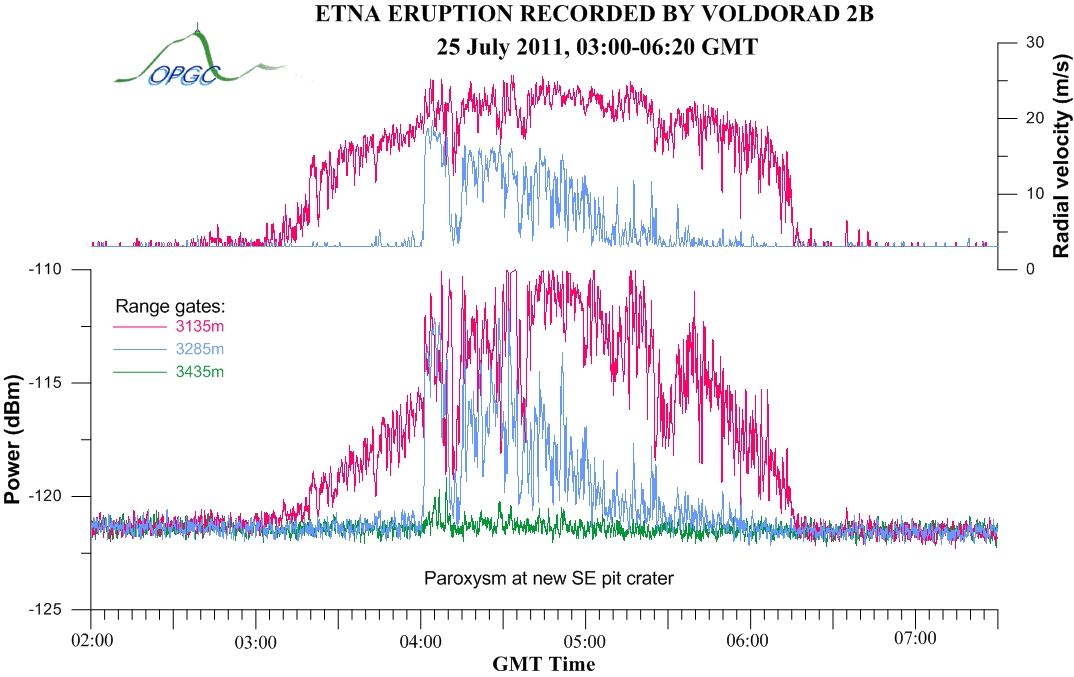
Le pit crater situé sur le flanc Est du cratère Sud-Est
de l'Etna a produit, à l'aube du 25 juillet 2011, sa septième éruption
depuis le début de l'année (cf. dernière éruptions enregistrées
par VOLDORAD 2B, et le site de l'INGV Catane http://www.ct.ingv.it/)
! Le panache de cendre a été entrainé vers l'Est et une coulée de
lave s'est épanchée en direction de la Vale del Bove. L'activité
explosive a commencé à être enregistrée par le radar de l'OPGC (situé
à La Montagnola) aux environs de 03:00 GMT dans la porte à 3135
mètres. La puissance a augmenté progressivement pour atteindre un
maximum de 10 dB vers 04:45, avec des vitesses radiales maximales
de 25 m/s reflétant certainement la dynamique convective du panache
de cendres à l'altitude du faisceau. Les signaux ont ensuite décliné
tranquillement jusque vers 06:20. Surimposée à cette tendance, une
augmentation brutale du signal visible dans 3 portes (3135m, 3285m,
3435m) s'est produite peu après 04:00, avant de décroître de façon
exponentielle jusque vers 06:00, avec une chute brutale notable
entre 04:10 et 04:15. Les fluctuations de l'amplitude du signal
sont probablement associées à des changements de direction ou de
vitesse du vent, entrainant plus ou moins de cendres dans le faisceau.
09 Juillet 2011
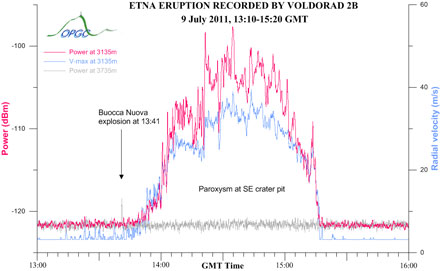
Le pit crater situé sur le flanc Est du cratère
Sud-Est de l'Etna a produit dans l'après-midi du 9 juillet
2011 sa cinquième éruption depuis le début
de l'année (cf. dernière éruptions
enregistrées par VOLDORAD 2B, et le site de l'INGV Catane
http://www.ct.ingv.it/). Dans
la matinée du 9 juillet, l'amplitude du tremor volcanique
a augmenté rapidement, accompagnée par la reprise
de l'activité Strombolienne dans le pit. Peu après
12:00 GMT, la lave a débordé par le bord oriental
du cratère, suivant le chemin des coulées de lave
des précédents paroxysmes en direction de la paroi
occidentale de la Valle del Bove. L'activité explosive a
commencé à être enregistrée par le radar
de l'OPGC à partir de 13:10 dans les portes vers 3135 mètres.
A 13:41, durant la phase initiale du paroxysme, une puissante explosion
s'est produite dans la Bocca Nuova, engendrant une intense émission
de cendres également détectée par le radar
dans la porte à 3735m pendant 2 minutes. Vers 13:45 GMT,
l'activité est passée d'explosions Stromboliennes
à une fontaine de lave continue, accompagnée d'un
panache de cendres dense de plusieurs kilomètres de hauteur.
La puissance de l'écho radar à 3135m excédait
20dB, les vitesses radiales maximales atteignant 40 m/s. Entrainé
par les vents vers le S et SE, le panache a provoqué des
chutes de cendres et lapilli sur les zones peuplées entre
Nicolosi et Catane au Sud (avec fermeture temporaire de l'aéroport),
et Trecastagni, Viagrande et Acireale vers le SE. Le paroxysme,
plus court que les précédents, a duré un peu
plus d'une heure. L'activité a ensuite fortement chuté
à partir de 15:15, l'amplitude du tremor volcanique retournant
à un niveau faible vers 15:30.
11 Mai 2011
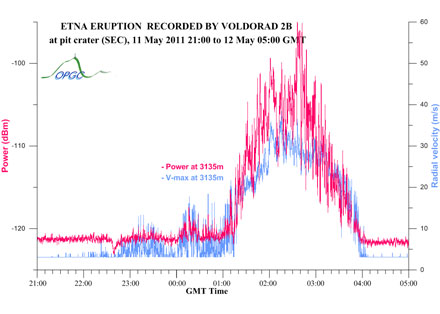
Le pit crater situé sur le flanc Est du cratère
Sud-Est de l'Etna a produit sa quatrième éruption
depuis le début de l'année (cf. rubrique dernière
éruptions, et http://www.ct.ingv.it/)
dans la nuit du 11 au 12 Mai 2011. A partir de 15:00 GMT le 11 Mai,
l'amplitude du tremor volcanique a augmenté progressivement,
et vers18:30 GMT, la lave a commencé à déborder
par le bord oriental du cratère. L'activité s'est
intensifiée dans les heures suivantes et peu avant 02:00
GMT le 12 Mai, a culminé avec des fontaines de lave qui ont
alimenté un panache de cendres entrainé par le vent
vers le SSE et nettement enregistré par le radar de l'OPGC.
La phase de fontaine a duré environ 2 heures, montrant une
diminuation graduelle vers 03:45. La chute brutale de l'amplitude
du tremor volcanique à 04:10 a marqué la fin de l'activité
éruptive.
10 Avril 2011
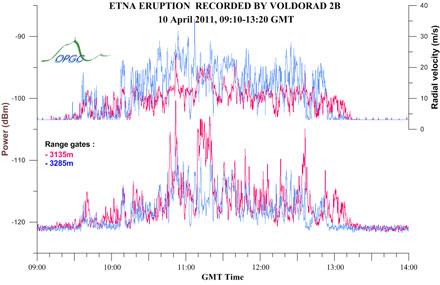
18 Février 2011
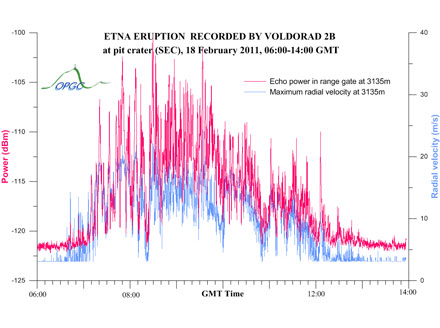
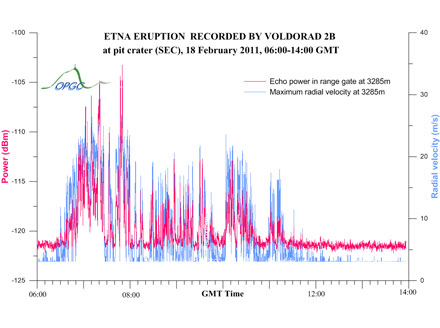
L’Etna célèbre la nouvelle année
L’Etna est entré en éruption dans
la nuit du 12 au 13 janvier 2011, produisant de spectaculaires fontaines
de lave et un panache de cendres, à partir du pit crater
situé sur le flanc oriental du cône du cratère
Sud Est. L’épisode éruptif qui avait débuté
le 11 janvier 2011 par une faible activité Strombolienne
à l’intérieur du pit crater, s’est intensifié
le 12 janvier, culminant dans la nuit par des fontaines de lave
de 300-500m de hauteur et une colonne éruptive de plusieurs
kilomètres de hauteur. La dispersion et les chutes de cendres
vers le Sud ont conduit à la fermeture de l’aéroport
international de Catane durant plusieurs heures. De volumineuses
coulées de lave ont également été émises
sur le flanc Est jusqu’à plus de 4 km, atteignant la
Valle del Bove sans faire de victime. L’activité explosive
a pris fin vers 23:55.
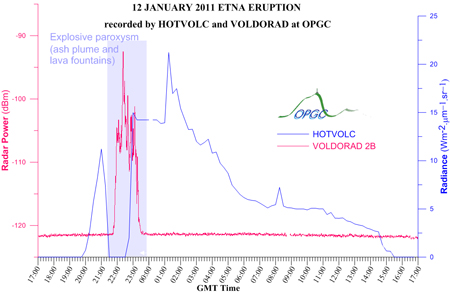
Enregistrements simultanés au sol et par satellite
de l’éruption de l’Etna du 12 janvier 2011 par
les services VOLDORAD
et HOTVOLC
de l’OPGC. Le radar Doppler (VOLDORAD 2B) mesure la puissance
retrodiffusée par les ejectas traversant le faisceau radar
au dessus des cratères sommitaux, et révèle
la phase paroxysmale de l’activité explosive (fontaines
de lave et panache de cendres) entre 21h45 et 23h30 GMT. En parallèle,
les calculs de la radiance à 3.9 microns réalisés
par le service HOTVOLC à partir des images du satellite MSG-SEVIRI
révèlent les anomalies thermiques associées
à l’épanchement de larges coulées de
lave. La chute de la radiance mesurée par satellite entre
21:30 et 23:00 GMT est directement associée à l’émission
du panache de cendres dans l’atmosphère, empêchant
la détection des émissions infrarouges émanant
des coulées de lave.
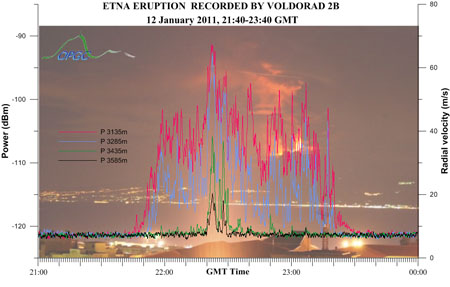
L’activité explosive a aussitôt
été détectée par le radar de l’Observatoire
de Physique du Globe de Clermont-Ferrand. Installé à
3 km au Sud de la bouche éruptive, ce radar Doppler surveille
en continu l’activité des cratères sommitaux,
en collaboration avec l’INGV de Catane en Sicile. Les premiers
résultats indiquent que l’activité la plus explosive
s’est produite le 12 janvier entre 21h40 et 23h40 GMT (= heure
locale – 1h). Le paroxysme a été atteint vers
22h20 - 22h30 GMT, les vitesses d’éjection enregistrées
par le radar dépassant alors 70 m/s (250 km/h). Cette éruption
a produit les signaux les plus puissants enregistrés par
le radar depuis son installation en juillet 2009.
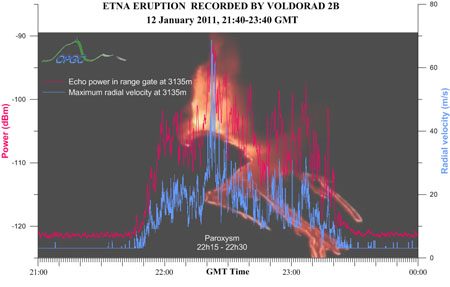
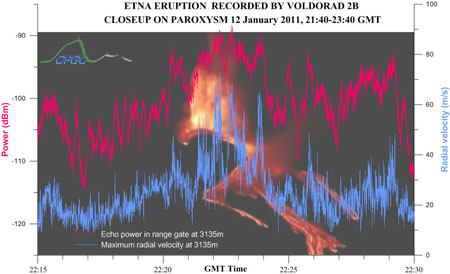
Communiqué
CNRS-INSU du 18/01/2011
2010
Detection by VOLDORAD 2B of the eruption of Bocca
Nuova on December 22 2010
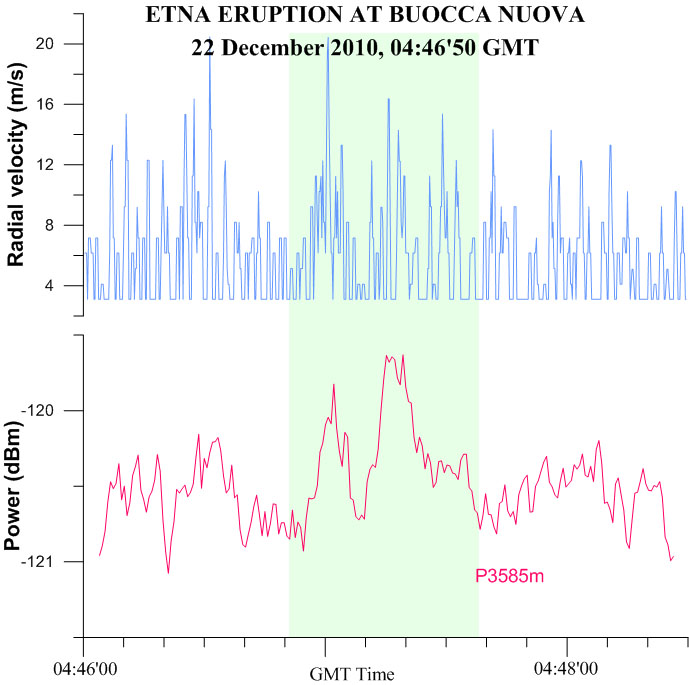
Detection by VOLDORAD 2B of the eruption of the western
vent of Bocca Nuova on August 25 2010
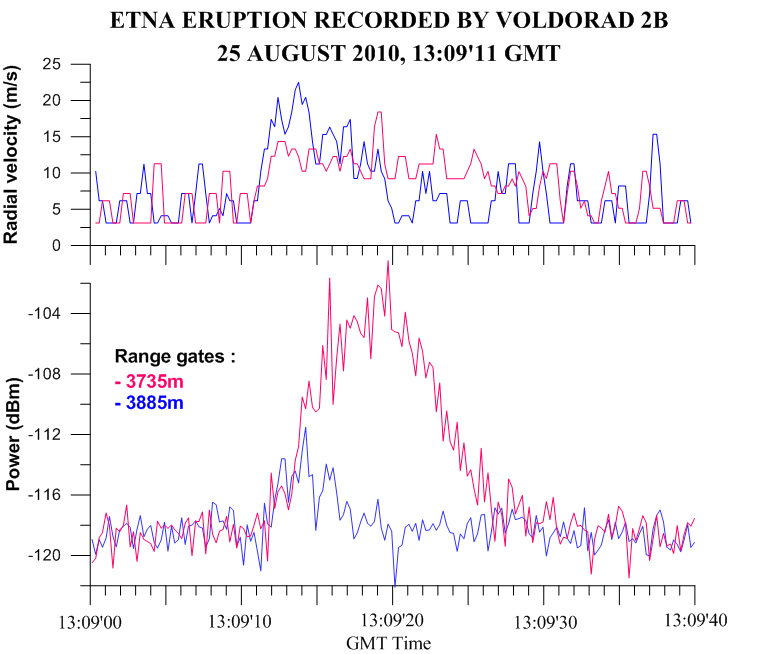
Radar signal of the April 8, 2010, eruption
|










































